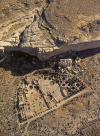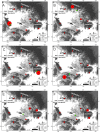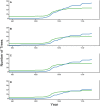Eleventh-century shift in timber procurement areas for the great houses of Chaco Canyon
- PMID: 26644552
- PMCID: PMC4747737
- DOI: 10.1073/pnas.1514272112
Eleventh-century shift in timber procurement areas for the great houses of Chaco Canyon
Erratum in
-
Correction for Guiterman et al., Eleventh-century shift in timber procurement areas for the great houses of Chaco Canyon.Proc Natl Acad Sci U S A. 2016 Feb 9;113(6):E811. doi: 10.1073/pnas.1525340113. Epub 2016 Jan 19. Proc Natl Acad Sci U S A. 2016. PMID: 26787863 Free PMC article. No abstract available.
Abstract
An enduring mystery from the great houses of Chaco Canyon is the origin of more than 240,000 construction timbers. We evaluate probable timber procurement areas for seven great houses by applying tree-ring width-based sourcing to a set of 170 timbers. To our knowledge, this is the first use of tree rings to assess timber origins in the southwestern United States. We found that the Chuska and Zuni Mountains (>75 km distant) were the most likely sources, accounting for 70% of timbers. Most notably, procurement areas changed through time. Before 1020 Common Era (CE) nearly all timbers originated from the Zunis (a previously unrecognized source), but by 1060 CE the Chuskas eclipsed the Zuni area in total wood imports. This shift occurred at the onset of Chaco florescence in the 11th century, a time with substantial expansion of existing great houses and the addition of seven new great houses in the Chaco Core area. It also coincides with the proliferation of Chuskan stone tools and pottery in the archaeological record of Chaco Canyon, further underscoring the link between land use and occupation in the Chuska area and the peak of great house construction. Our findings, based on the most temporally specific and replicated evidence of Chacoan resource procurement obtained to date, corroborate the long-standing but recently challenged interpretation that large numbers of timbers were harvested and transported from distant mountain ranges to build the great houses at Chaco Canyon.
Keywords: Ancestral Puebloans; archaeology; dendrochronology; human–environment interactions; timber origins.
Conflict of interest statement
The authors declare no conflict of interest.
Figures










Comment in
-
Long-distance wood procurement and the Chaco florescence.Proc Natl Acad Sci U S A. 2016 Feb 2;113(5):1118-20. doi: 10.1073/pnas.1521904113. Epub 2015 Dec 17. Proc Natl Acad Sci U S A. 2016. PMID: 26677872 Free PMC article. No abstract available.
-
Archaeology: Sources of Chaco wood.Nature. 2016 Jan 7;529(7584):31-3. doi: 10.1038/nature16864. Epub 2015 Dec 23. Nature. 2016. PMID: 26700808 No abstract available.
References
-
- Lekson SH, editor. The Archaeology of Chaco Canyon: An Eleventh-Century Pueblo Regional Center. School of American Research Press; Santa Fe, NM: 2006.
-
- Doyel DE ed. (1992) Anasazi Regional Organization in the Chaco System. Anthropological Paper No. 5 (Maxwell Museum of Anthropology, Univ of New Mexico, Albuquerque)
-
- Dean JS, Warren RL. Dendrochronology. In: Lekson SH, editor. The Architecture and Dendrochronology of Chetro Ketl, Chaco Canyon, New Mexico. US Department of the Interior National Park Service; Albuquerque, NM: 1983. pp. 105–240.
-
- Betancourt JL, Dean JS, Hull HM. Prehistoric long-distance transport of construction beams, Chaco Canyon, New Mexico. Am Antiq. 1986;51(2):370–375.
-
- Durand SR, Shelley PH, Antweiler RC. Trees, chemistry, and prehistory in the American Southwest. J Archaeol. 1999;26(2):185–203.
Publication types
LinkOut - more resources
Full Text Sources
Other Literature Sources

